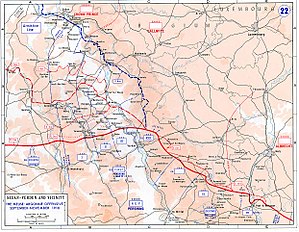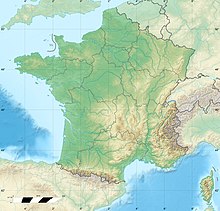Meuse Argonne Offensive
| Meuse-Argonne Offensive | |||||||
|---|---|---|---|---|---|---|---|
| Part of the Western Front of World War I | |||||||
 Map of the area, 1918. |
|||||||
|
|||||||
| Belligerents | |||||||
|
|
|
||||||
| Commanders and leaders | |||||||
|
|
|
||||||
| Units involved | |||||||
|
|
|
||||||
| Strength | |||||||
|
380 tanks 840 planes 2,780 artillery pieces |
450,000 personnel | ||||||
| Casualties and losses | |||||||
|
Total: 192,000 26,277 killed 95,786 wounded |
Total: c. 126,000 28,000 dead 26,000 POWs taken by Americans 30,000 POWs taken by French 874 artillery pieces captured by both |
||||||
|
|
|||||||
The Meuse-Argonne Offensive, also known as the Maas-Argonne Offensive and the Battle of the Argonne Forest, was a major part of the final Allied offensive of World War I that stretched along the entire Western Front. It was fought from 26 September 1918, until the Armistice of 11 November 1918, a total of 47 days. The Meuse-Argonne Offensive was the largest in United States military history, involving 1.2 million American soldiers, and was one of a series of Allied attacks known as the Hundred Days Offensive, which brought the war to an end. The battle cost 28,000 German lives and 26,277 American lives, making it the largest and bloodiest operation of World War I for the American Expeditionary Force (AEF), which was commanded by General John J. Pershing, and the bloodiest battle in American history. American losses were exacerbated by the inexperience of many of the troops and tactics used during the early phases of the operation.
The Meuse-Argonne was the principal engagement of the AEF during World War I.
The logistical prelude to the Meuse attack was planned by then-Colonel George Marshall who managed to move American units to the front after the Battle of Saint-Mihiel. The big September/October Allied breakthroughs (north, centre and south) across the length of the Hindenburg Line – including the Battle of the Argonne Forest – are now lumped together as part of what is generally remembered as the Grand Offensive (also known as the Hundred Days Offensive) by the Allies on the Western Front. The Meuse-Argonne offensive also involved troops from France, while the rest of the Allies, including France, Britain and its dominion and imperial armies (mainly Canada, Australia and New Zealand), and Belgium contributed to major battles in other sectors across the whole front.
...
Wikipedia

